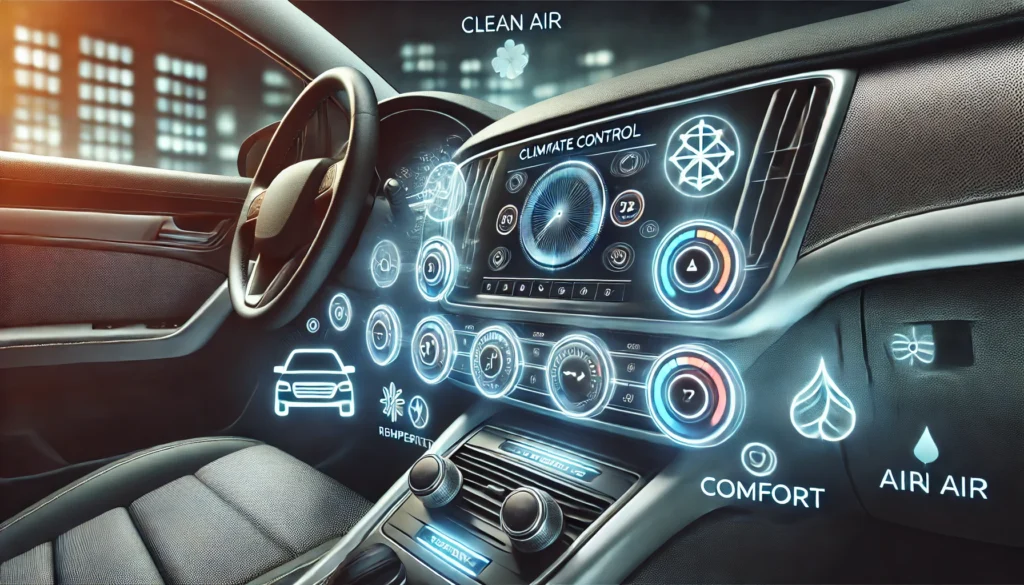The automotive industry is a powerhouse of innovation, undergoing rapid transformations. These are prime examples of this progress, which has evolved significantly to enhance driver and passenger comfort and safety. These systems regulate temperature, impacting air quality and overall well-being.
These Climate Control Systems are very important for maintaining the comfort and safety of drivers and passengers because they control temperature and increase the vehicle’s cabin’s cleanliness. Control of vehicle climate is remembered to ensure risks are tamed, health is boosted, and comfort when driving is promoted.
This paper shall look at Climate Control Systems in cars, how they work, the different types in the market, and what advantages users stand to gain from them, with special attention shifted towards the quality of air in cars.
What Is a Climate Control System in Vehicles?
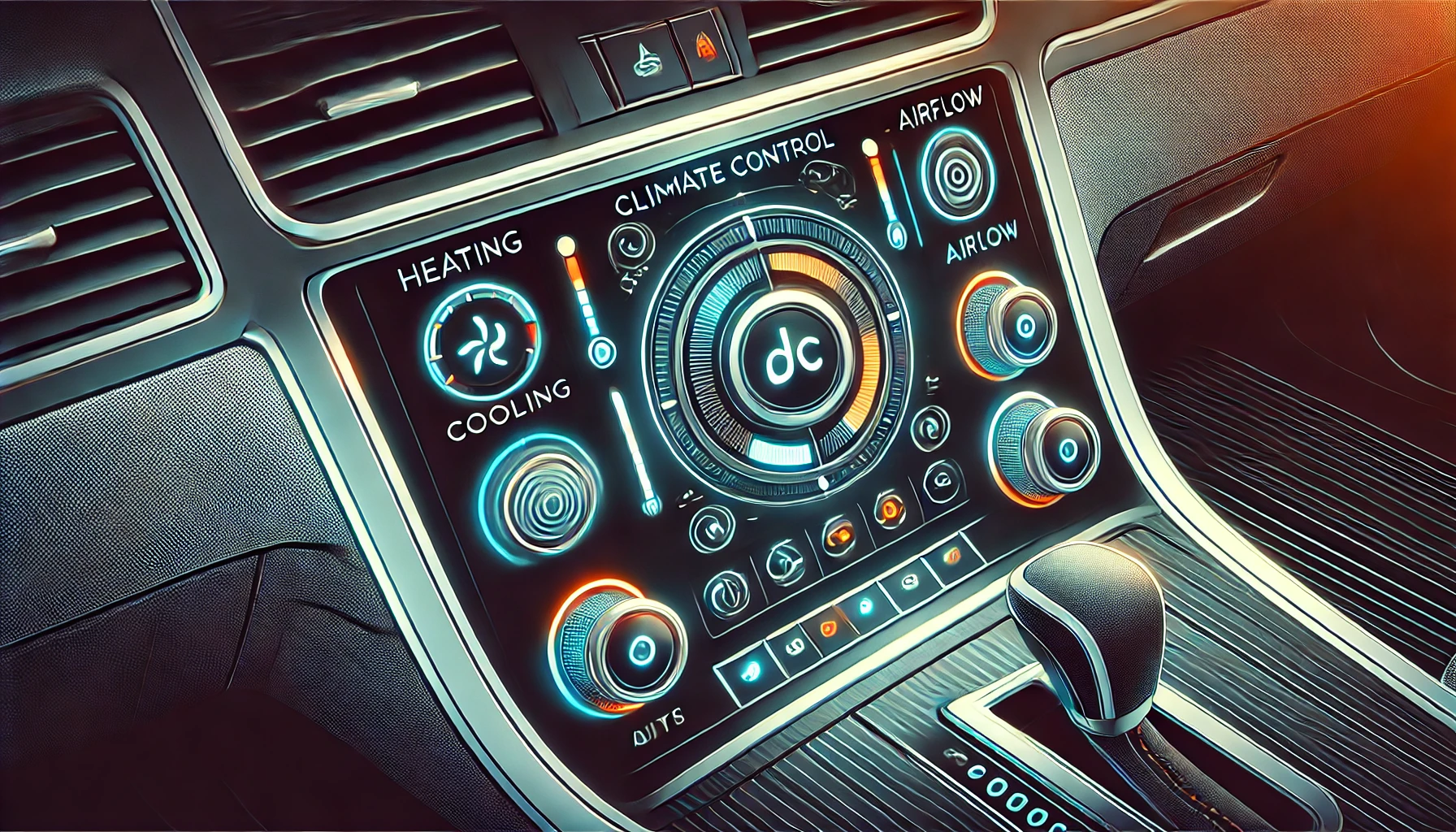
Vehicle climate control systems major into the elements and gadgets that help control vehicle compartments ‘ temperature, moisture, and air purity. Current climate control units go further than the HVAC systems, which were prevalent in previous centuries. They provide a complicated filtration system and self-controlled temperature and very often have more than one climate area where passengers can adjust the climate as they prefer.
These systems are now developed to solve specific issues, such as air quality, and this has become important today mainly due to increased time spent in automobiles and concern about the health effects of airborne particles and dust.
Air Quality and Its Impact on Health
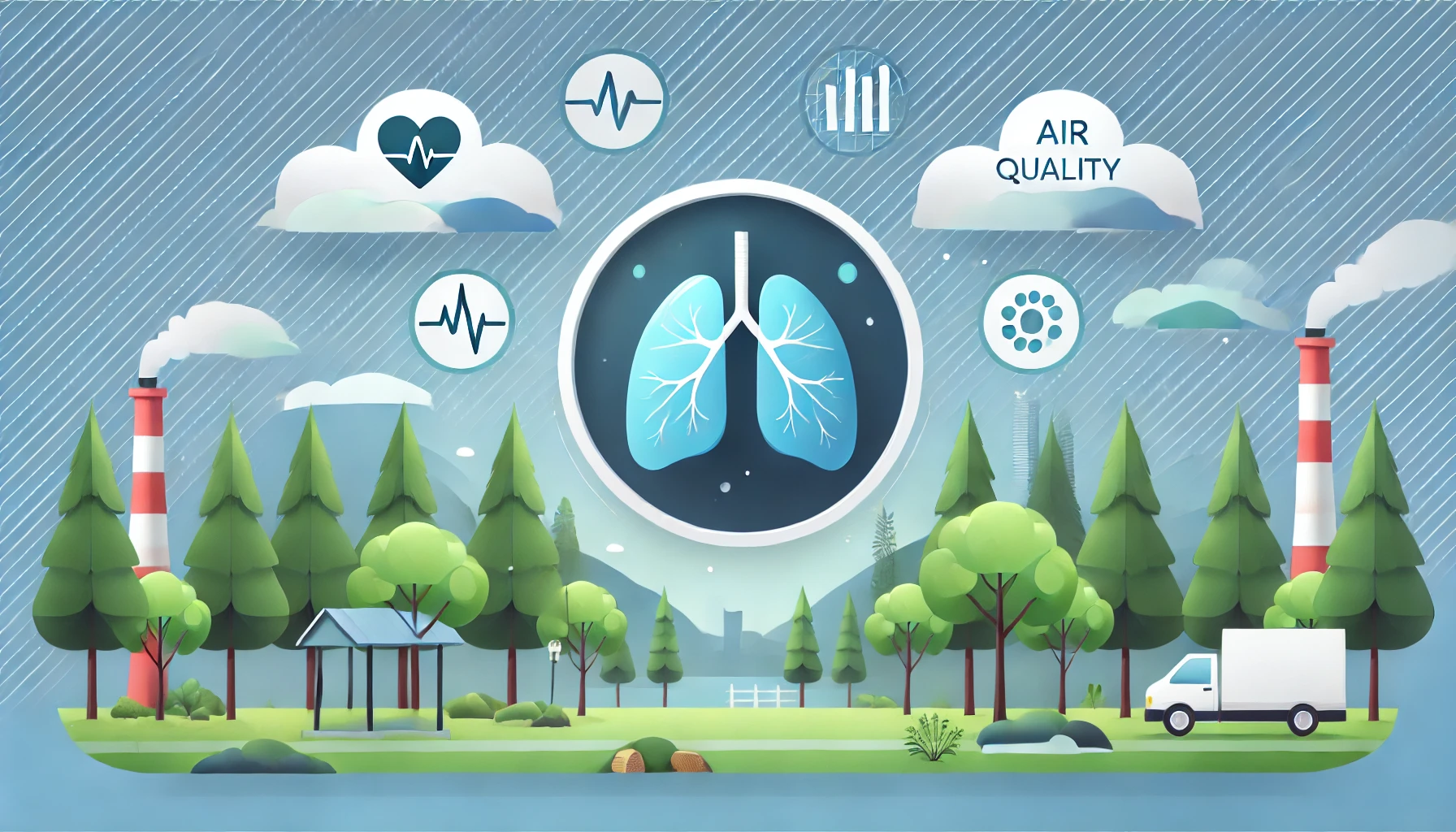
Research indicates that air quality inside a car affects the health status of the passengers. Vehicle research also indicates that CO, VOCs, and NO₂ concentrations might be considerably higher indoors than outside since pollution comes from emissions of tainted fumes, outer pollution, and interior car components.
- Asthma and allergies can be due to typical respiratory diseases.
- Decreased concentration level as this is unsafe when on the road.
Significantly influences the health and well-being of its occupants. Studies show that levels of pollutants like carbon monoxide (CO), volatile organic compounds (VOCs), and nitrogen dioxide (NO₂) can often be higher inside vehicles than outside due to emissions, external pollution, and the materials used in vehicle interiors. Poor air quality inside cars is linked to
- Respiratory issues, like asthma and allergies.
- Headaches and fatigue.
- Reduced focus and concentration, which can be a safety hazard.
Recently, the World Health Organization (WHO) identified air pollution as a threat that affects human health through numerous diseases that affect the respiratory and cardiovascular systems. This concern follows that the space within vehicles is closed, and if filled with these pollutants, it becomes detrimental to the health of the driver or any other occupant. Hence, it is important to adopt climate control systems that offer better filtration and air purification to help reduce such health impacts.
Components of Climate Control Systems Enhancing Air Quality
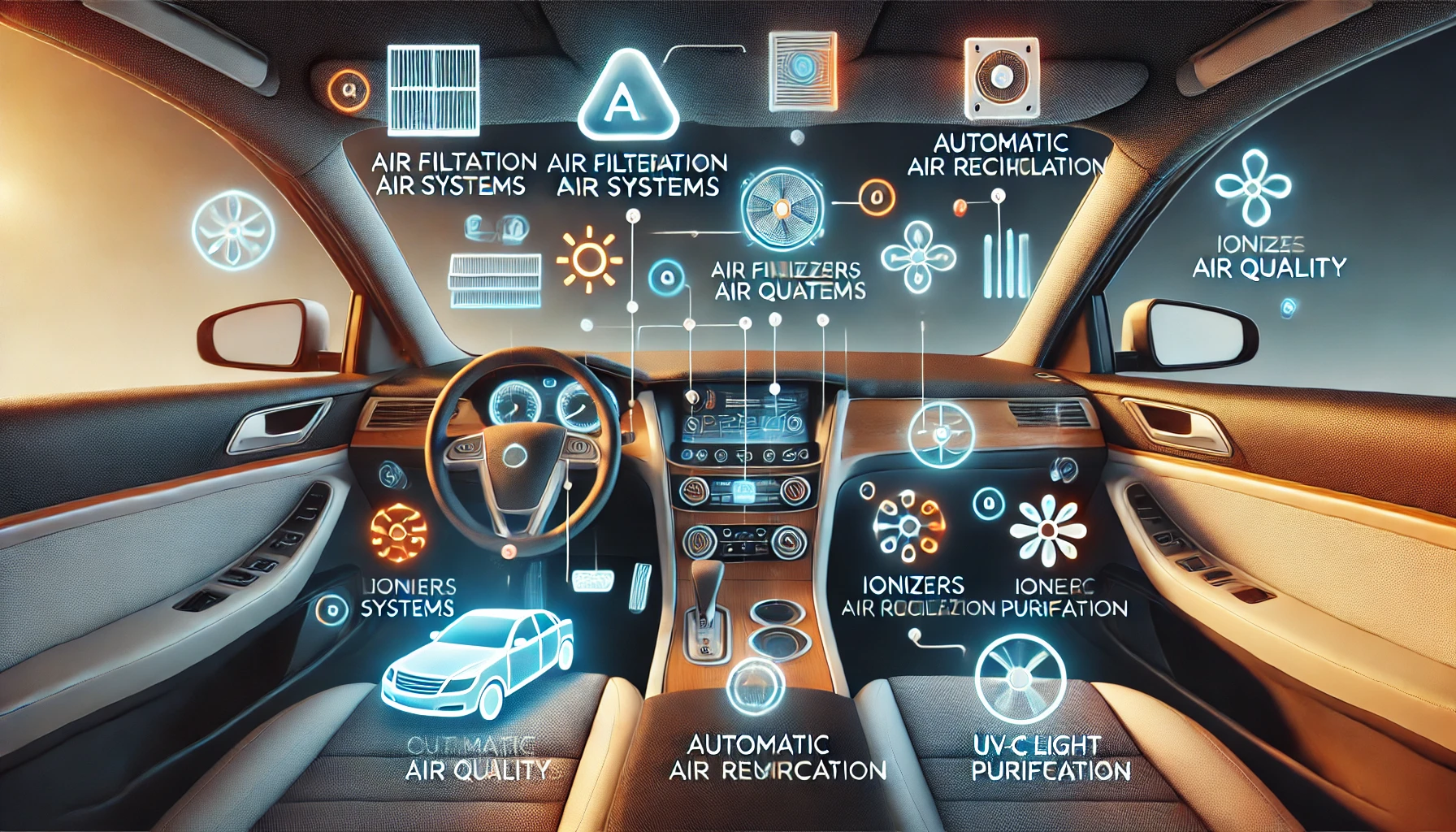
Today’s climate control systems combine techniques to free the cabin air from pollutants, allergens, and bacteria. Here’s a closer look at the components that help climate control systems improve air quality in vehicles:
1. Air Filtration Systems
- HEPA Filters: The latest automobiles have filters that contain HEPA and can trap extremely small particles, including dust, pollen, bacteria, etc. Such filters are of special use for allergic people or breathing disorder patients.
- Activated Carbon Filters: Carbon filters effectively capture toxic gases, including carbon monoxide, nitrogen dioxide, and other volatile organic compounds. The filters also remove odors and may vastly enhance the odor and cabin air quality.
2. Automatic Air Recirculation
Climate control systems in vehicles also incorporate sensors when determining the air quality on the exterior and reciprocating the fresh and recycled air. Within zones with poor outside air quality, like during traffic jams, the system may restrict fresh air flow and reinstate the circulation of used air, thereby controlling the admission of pollutants.
3. Ionizers and UV-C Light Purification
Other sophisticated climate control systems include ionizers, which release negative ions that attract particulate matter within the air so that it can be easily captured. UV-C light technology can also help enhance air quality by eradicating bacteria and viruses. Although these technologies can only be found in high-end cars, the feature is anticipated to become standard given the health-conscious generation demanding a healthier in-car climate.
4. Humidity Control
Ideal humidity control is therefore mandatory to make the environment comfortable and free from scores of complaints. Cooling and heating systems can control the humidity level by themselves to avoid dryness or nagging humidity within the car interior to halt bacteria and mold growth and alleviate breathing issues.
Comfort Benefits of Climate Control Systems
Besides increasing fresh air in the building environment, climate control systems offer many benefits concerning comfort, such as regulating temperature and lowering humidity levels. Luxury is not limited to comfort; it concerns those factors that allow safe driving on the highway. Research has found that a feeling of overheating or uncomfortableness in the cabin may lead to driver drowsiness and decreased concentration, slower response time, and the possibility of an accident.
Climate Control Systems in Electric Vehicles (EVs)
- Multi-Zone Climate Control: Some models have a feature to assign different temperatures to different zones so that each passenger can enjoy their comforting climate within a car, which is mostly convenient for long-haul journeys.
- Automatic Temperature Control (ATC): It includes an expressly set temperature wherein ATC systems regulate the temperatures of the HVAC, and the driver does not have to make frequent changes to the temperature.
- Seat Ventilation and Heating: Some of the latest car models come with heated and ventilated seat features, with the help of which at least one is always comfortable, especially when the weather is harsh.
Electrified Vehicles: Climate Control Systems: Why Do We Need Them?
Climate control systems are particularly important for electric vehicles because they impact battery efficiency and range. In EVs, the climate control system incorporates electrical power; therefore, an eco-friendly system can extend the battery lifespan and improve efficiency during the drive. Technological solutions to minimize energy use include heating and cooling systems that help maintain the cabin’s comfort without power-hungry AC and heater systems that substantially diminish the EV range.
Climate Control System: Facts and Figures
Several studies emphasize the importance of climate control systems in improving air quality and comfort within vehicles:
1. Air Quality
Research done by the EPA shows that levels of pollutants inside cars can be five times higher than those outside, so there is a need for proper filtration and air purification.
2. Driver Comfort and Safety
Research from Harvard School of Public Health indicates that driver activity response risk is reduced by up to 20% if the temperature inside the cabin exceeds 80°F (27°C). Since temperature control is vital in isolating the driver’s cabin, it can significantly help avoid fatigue, hence sharp concentration.
3. Global Market Demand
Ally, situated in India, Allied Market Research predicts the global automotive HVAC market will reach $ 33 billion in 2026 due to customers longing for optimized vehicle comfort and air quality.
Future Trends in Vehicle Climate Control Systems
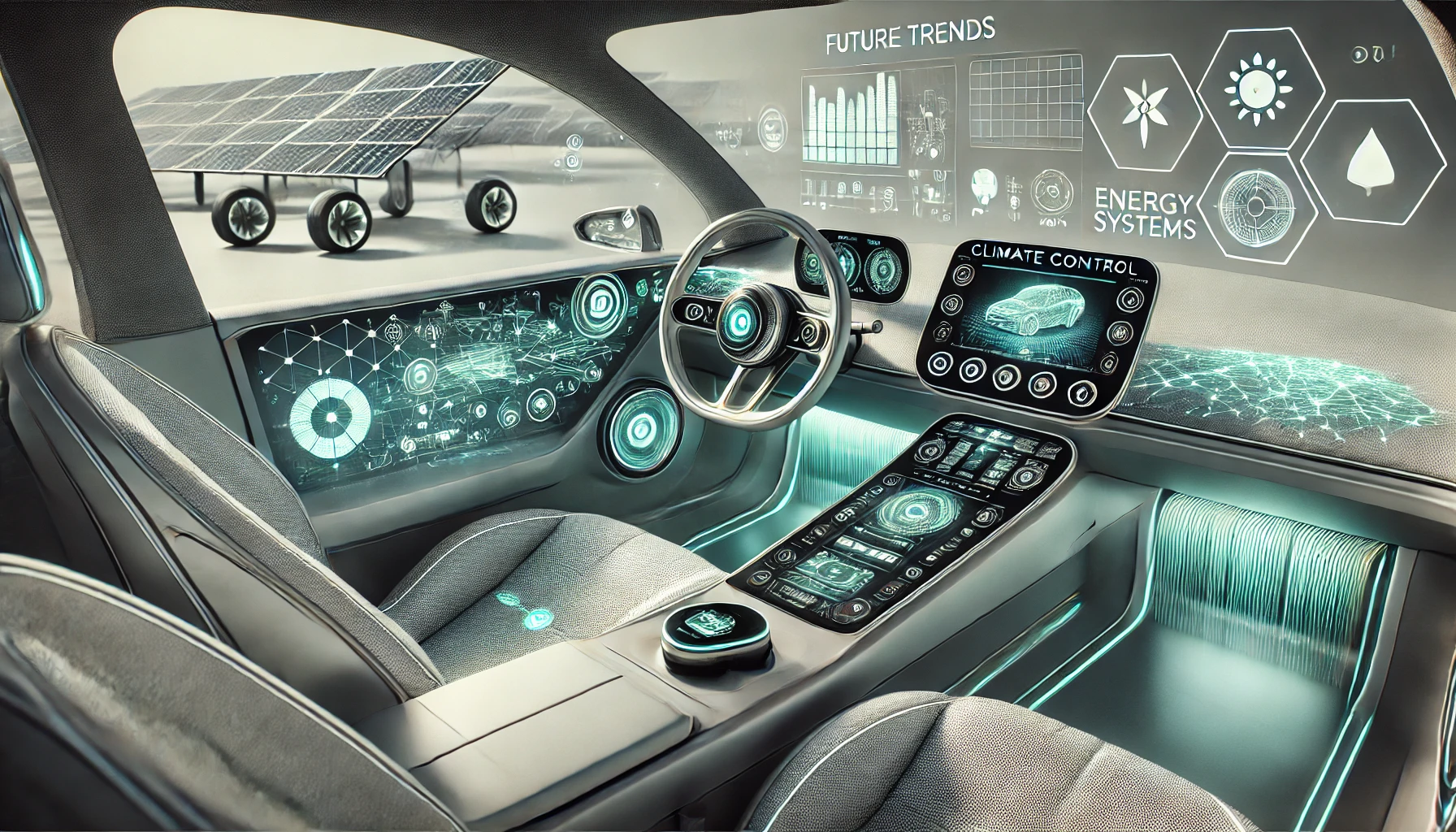
That is why one can assume that climate control systems will only become more complex and environmentally friendly with the steady advancement of automotive technology. Below are a few trends that would help you anticipate future changes and plan your strategy accordingly:
1. AI-Driven Climate Control
: Autonomous may use collected data about users and the conditions on the site and make changes on a real-time basis without input from the user, an exemplary implementation of personalization.
2. Connected Vehicle Technology
Thus, in the future, through IoT (Internet of Things), vehicles may ”breathe” the external air quality conditions and adapt the cabin conditions to the optimum level possible for its occupants.
3. Sustainable Cooling and Heating
New systems that use low-global-warming refrigerants and energy-efficient heat pumps are being launched to minimize the environmental effects of car climate control systems. These technologies are particularly relevant to EVs because every energy lost must be taken from the battery or generated, and every energy saved can be reused.
Why Choose a Vehicle with Advanced Climate Control?
Spending money on a car equipped with efficient climate control has many advantages beyond the ability to cool or heat. It also means that improved air quality serves the passengers ‘ well-being needs and promotes lifetime and comfort. Depending on the modern climate control systems that provide better filtrations and humidity, including temperature stability, every travel becomes as comfortable and safe as possible.
Conclusion: Enhancing Comfort and Health with Advanced Climate Control Systems
HVAC systems have evolved from the basic splits to technology and features that vastly transform the inner environment and quality. These systems eliminate the unhealthy air particles of pollutants, regulate the amount of humidification, and control the temperature; this, therefore, makes the passengers comfortable as they are put in a healthy environment.
Given that it is proven by statistical data that such systems contribute to the improvement of the vehicles ‘ performance, and knowing that the further development trends are programmed toward the constant enhancement of these features, one can but agree that climate control systems play a crucial role in achieving a smoother and more comfortable ride. It is still vital to know what changes an advanced climate control system brings when purchasing a new car or just studying the features of vehicles.
————————————————————————————————————————————————–
Frequently Asked Questions
1. Can the climate control module be repaired?
2. Can climate control?
————————————————————————————————————————————————–
3. Can you climate control your garage?
4. How does climate control work in a car?
5. How to control climate change?
Controlling climate change involves reducing greenhouse gas emissions, transitioning to renewable energy sources, conserving resources, and adopting sustainable practices.
————————————————————————————————————————————————–
6. How to climate control a garage?
To climate control a garage:
- Insulate walls, doors, and ceilings.
- Install HVAC systems or portable air conditioners/heaters.
- Use dehumidifiers or ventilation systems.
————————————————————————————————————————————————–
7. What is climate control in the world?
In a global context, climate control refers to efforts to mitigate or manage changes in Earth’s climate, often through policies and technologies aimed at reducing carbon emissions and enhancing sustainability.
————————————————————————————————————————————————–
8. What is climate control in The Giver?
In The Giver by Lois Lowry, climate control refers to suppressing natural weather patterns to create a controlled, predictable environment for the community.
————————————————————————————————————————————————–
9. What is climate control air conditioning?
Climate control air conditioning maintains a set temperature and adjusts automatically, often including features like humidity control and air filtration.
————————————————————————————————————————————————–
10. When is climate control payment?
This question needs clarification. Climate-related fees or energy costs depend on the context (e.g., electric bills, environmental taxes).
————————————————————————————————————————————————–
11. Where is climate control on a Tesla?
The climate control settings in Tesla vehicles can be accessed on the central touchscreen under the “Climate” menu.
————————————————————————————————————————————————–
12. Where is climate control on ResMed AirSense 11?
On the ResMed AirSense 11, climate control settings are in the device’s menu under “Comfort Settings,” where you can adjust the humidifier and tubing temperature.
————————————————————————————————————————————————–
13. Who controls climate change?
No single entity controls climate change, but it is addressed collectively by governments, organizations, scientists, and individuals through policies, technology, and actions.
————————————————————————————————————————————————–
14. Why climate control storage?
Climate-controlled storage protects sensitive items like electronics, furniture, and documents from temperature and humidity fluctuations.
————————————————————————————————————————————————–
15. Climate Control Systems in Vehicles: Enhancing Comfort and Air Quality
Climate control systems in vehicles enhance comfort by maintaining consistent cabin temperature and improving air quality through filtration and humidity management.
————————————————————————————————————————————————–
16. What can be achieved with a climate control system in a vehicle?
A vehicle climate control system ensures a comfortable environment, reduces fogging, and maintains air quality.
————————————————————————————————————————————————–
17. What does climate control do in a car?
Climate control automatically regulates cabin temperature, air distribution, and airflow to maintain passenger comfort.
————————————————————————————————————————————————–
18. What is the purpose of a climate control system?
The purpose is to regulate indoor climate by adjusting temperature, humidity, and air quality for comfort and efficiency.
————————————————————————————————————————————————–
19. What is the purpose of the air conditioner and heating controls in the vehicle cabin?
These controls regulate temperature, airflow, and defrosting to enhance comfort and visibility.
————————————————————————————————————————————————–
20. What is climate control inside a car?
Climate control in a car refers to systems that automatically adjust the heating, cooling, and ventilation to maintain a desired cabin temperature.
————————————————————————————————————————————————–
21. What is the role of the air in climate control?
Air plays a central role by acting as the medium for distributing heating, cooling, and ventilation within the controlled environment.
————————————————————————————————————————————————–
22. What is the best temperature for climate control in a car?
The ideal temperature is around 22–24°C (72–75°F) for comfort and efficiency.
————————————————————————————————————————————————–
23. What is an example of climate control?
An example is an HVAC system that automatically maintains a set temperature and humidity in a car or building.
————————————————————————————————————————————————–
For comprehensive insights and in-depth information, explore our curated collection of articles Click Below:
A Comprehensive Guide to Honda Accord: A Timeless Choice for 2024 Car Buyers
Case Studies of Cities Heavily Impacted by Smog from Vehicle Emissions
Enhancing Air Quality and Comfort The Function of Climate Control Systems in Automobiles
Global Data – EV Tracking System & Emission Monitoring
Global Road Safety & Vehicle Standards_ A Complete Guide
Riding High – The Top 5 Vehicles Dominating 2024
Toyota Corolla 2024 Review – Everything You Need to Know About Features, Price, and Performance
The 15 Leading Startups Revolutionizing Autonomous Vehicles in 2024
The Evolution and Appeal of Sports Cars_ A Comprehensive Analysis
The Impact of Green Technology on the Automobile Industry
The Science Behind Car Safety Features_ How They Work
From Seatbelts to Sensors_ The Journey of Car Safety Innovations
How to Buy a Used Car_ A Step-by-Step Guide
————————————————————————————————————————————————
References
Environmental Protection Agency (EPA)
- Source: EPA Indoor Air Quality
World Health Organization (WHO)
- Source: WHO Air Quality and Health
Harvard School of Public Health
- Source: Harvard T.H. Chan School of Public Health
Allied Market Research
- Source: Allied Market Research – Automotive HVAC Market
National Institute for Occupational Safety and Health (NIOSH)
- Source: NIOSH – Air Quality in Enclosed Spaces
Environmental Defense Fund (EDF)
- Source: Environmental Defense Fund – Vehicle Emissions
We are a Trusted Name in Automotive Industry & Technologies!
Our Trusted Partners
We are proud to collaborate with industry leaders to deliver exceptional value and quality to our customers:
- Auto World Japan: A trusted name in exporting high-quality Japanese vehicles worldwide.
- BE FORWARD: A global leader in selling and exporting used cars with an excellent reputation.
These partnerships allow us to bring you reliable, top-tier services and products directly.

